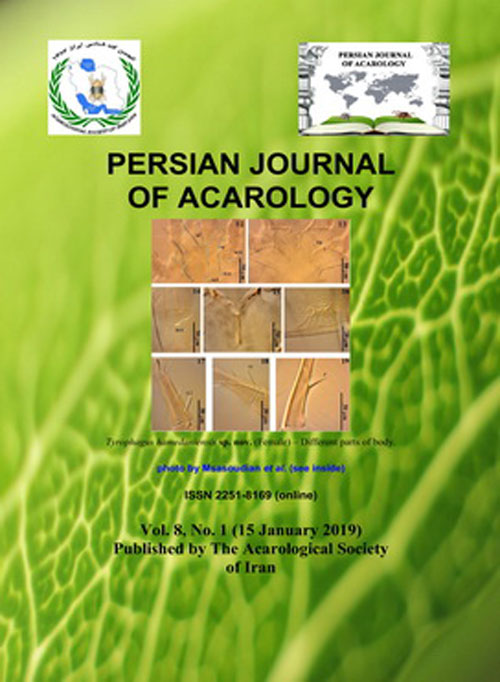فهرست مطالب

Persian Journal of Acarology
Volume:8 Issue: 1, Winter 2019
- تاریخ انتشار: 1397/11/03
- تعداد عناوین: 8
-
-
Pages 1-9A new species belonging to the family Acaridae, Tyrophagus hamedaniensis sp. nov., is described and illustrated from specimens collected from soil and litter beneath forest trees, Hamedan province, Iran. Also, a key to Iranian species of the genus Tyrophagus is provided.Keywords: Description, fungivorous, Hamedan, mite, Sarcoptiformes.
-
Pages 11-18Aegyptobia gotohi sp. nov. is described and illustrated based on female specimens collected from barberry bushes, Berberis sp. (Berberidaceae) in Nurabad, Lorestan province, Iran.Keywords: Berberidaceae, Iranian species, Nearctic, Nurabad, Western Palearctic.
-
Pages 19-26Schizotetranychus ugarovi Wainstein is redescribed from new materials collected on Alhagi maurorum (Fabaceae) in Iran, representing a new country for this species.Keywords: Alhaji, new record, redescription, Sirjan, spider mites
-
Pages 27-46Pseudolynchia canariensis (Diptera: Hippoboscidae) is a parasite of pigeons but also a host for hyperparasitic mites living on the same avian hosts. Four species and subspecies of mites found on this louse fly, Myialges anchora, Promyialges italicus sp. nov., Promyialges lophortyx (Astigmata: Epidermoptidae), and Ornithocheyletia hallae hallae (Prostigmata: Cheyletidae), are described or redescribed. One new species of feather mites is described from Tuscany, Pisa, Italy, from Pseudolynchia canariensis (Mcquart, 1840) from Columba livia (Gmelin, 1789). This is the first report of the genera Myialges and Ornithocheyletia for the Iranian fauna, while the subspecies Ornithocheyletia hallae hallae represents a new report for Asia. Specimens of O. hallae from populations in Italy and in Iran differ morphologically. According to these findings, we recognized two subspecies, Ornithocheyletia hallae hallae and O. hallae similis.Keywords: Description, hyperparasites, louse flies, Myialges, Ornithocheyletia, parasites, phoresy
-
Pages 47-56Tetranychus kanzawai Kishida (Acari: Tetranychidae) is considered an important pest of different crops; its damage significantly has increased in recent years in some regions of Iran. The life history parameters of T. kanzawai on six red bean genotypes (KS31288, KS31292, KS31287, KS31285, Akhtar and Goli) at 28 ± 1 ºC, 50 ± 10% RH and a photoperiod of 16:8 (L: D) h were studied. The life table was constructed considering the female characters of the studied cohort. The developmental time of T. kanzawai differed among tested genotypes and ranged from 8.50 days on KS31285 to 9.77 days on KS31292. The highest and lowest value of immature survival rate were 0.85% on KS31285 and 0.77% on KS31287, respectively. The total fecundity varied significantly on different genotypes, being the highest on KS31288 (71.40 eggs) and the lowest on Akhtar (19.44 eggs). The mean generation time (T) was shortest on Akhtar (8.54 days) and longest on KS31288 (12.09 days). The lowest intrinsic rate of natural increase (rm) was recorded on KS31287 (0.229 day-1) and the highest values of this parameter were obtained on KS31288 (0.303 day-1). According to our results, KS31288 and KS31287 were partially susceptible and resistant genotypes to T. kanzawai, respectively. The findings of this study provide new insights to design a more comprehensive pest management program for this pest.Keywords: Antibiosis resistance, bean genotypes, female, Kanzawa spider mite, life history
-
Pages 57-68Spiromesifen is a widely used pesticide (acaricide) for controlling the two-spotted spider mite, Tetranychus urticae Koch (Acari: Tetranychidae) which is a severe pest on strawberries in Mersin region of Turkey. The experiment was carried out, under laboratory conditions (25 ± 1 °C, 60 ± 10% relative humidity and 16-h light) for the evaluation of responses of the spider mite against spiromesifen. The responses (mortality rate, sensitivity) of mite populations to pesticide were estimated by calculation of the mortality rate or effectiveness ratio (% Abbott), for three different concentrations (recommended, 1/2 and 1/4 of applied rate). According to effectiveness ratio, the mite species shows oversensitivity to eggs and immature stages for spiromesifen which were classified as harmful. Adults of T. urticae were found less susceptible to this acaricide. Spiromesifen was considered to be the most toxic to the eggs. Eggs hatching ratio has been reduced by almost 90–100% at the recommended and other applied concentra-tions at 36–72 h (0.5, 0.25 and 0.125 μL/mL). Spiromesifen was found to be highly toxic on eggs hatching ratio at 48 hours. The highest effectiveness ratios estimated for immature stages were 79, 89 and 98% for each concentration respectively (0.5, 0.25 and 0.125 μL/mL). Given the adult stage of the two-spotted spider mite, the highest response was carried out at the recommended concentration, which has the mortality rate reaching over 96 % after 60 hours.Keywords: Bioassay, effectiveness, sensitivity, spiromesifen, strawberry, Tetranychus urticae
-
Pages 69-72There are very less number of studies on plant mites from northern part of Kerala, a state province in India. The objective of this study was to have an extensive survey on plant mites from northern part of Kerala. 13 Randomly selected plants were surveyed in this study. A total of 12 species of phytophagous mites belonging to 4 families were recovered. Spider mites from the family Tetranychidae was the most prominent species recovered during our survey. Brinjal presented highest diversity in terms of variety of mites that recovered. This study urges the farmers to consider mites as serious pests and develop a proper pest management program accordingly.
-
Pages 73-76In a faunistic survey on edaphic Mesostigmata in some parks in Kerman City, a female specimen of M. caelatus Berlese, 1918 was collected which considered as a new record for Iran mite fauna.

